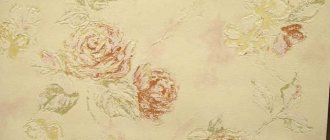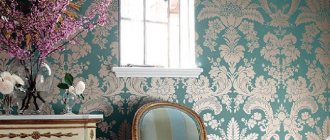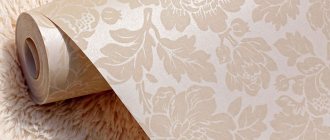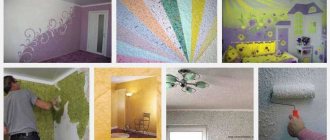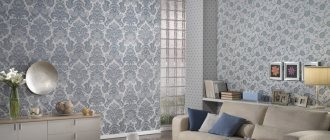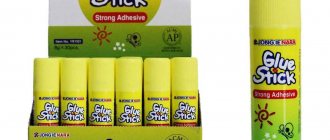Is it possible to wash non-woven wallpaper?
The advantage of non-woven wallpaper is that it can be washed.
Non-woven wallpaper consists of several layers:
- 1st – base, made of non-woven material, the strength of which is several times higher than that of paper;
- 2nd – external (decorative), differs in strength indicators.
The degree of resistance to wet cleaning is determined precisely by the features of the outer coating:
- Compact vinyl . They are a relief pattern made of PVC. The glossy surface is water-resistant and can withstand gentle cleaning methods using liquid products. A type of vinyl wallpaper - silk-screen printing, is also characterized by high resistance to mechanical stress.
- Foamed . The outer surface is made in the form of a three-dimensional pattern. Traces remain on them even with slight pressure with a hard, pointed object. Withstands washing with soft materials.
- For painting . Care rules depend on the type of paint. Latex and water-dispersed paints, after drying, show high resistance to moisture.
How and how to clean non-woven wallpaper
You can return walls with a convex pattern to their original appearance as follows:
- Remove dust with a vacuum cleaner turned on at minimum power.
- Prepare an aqueous solution based on laundry soap (you can use dishwashing liquid or shampoo instead) in a ratio of 1:10.
- Soak microfiber or foam rubber with liquid.
- Wipe the surface from bottom to top to avoid smudges.
- Remove excess moisture with paper or cotton towels.
Smooth surfaces do not require pre-cleaning with a vacuum cleaner. To facilitate the work process, use a spray bottle to apply liquid.
After washing, it is forbidden to open the windows; the walls should be protected from drafts until they dry completely.
Important! It is prohibited to use aggressive liquids containing acid and abrasive components.
Wallpaper structure
If the question arises of how to wash vinyl wallpaper, then you should first understand the structure of the material. They are manufactured using a special technology that can withstand heavy loads. Most often they are called two-layer. In this case, the second layer can be different:
- paper;
- non-woven
If you have a paper base, it will not withstand moisture. This is worth considering from the very beginning. Yes, manufacturers may label that they can also be wiped with a damp cloth, but it is better to do this very carefully. Although the top layer is largely responsible for moisture protection, water getting on the paper inevitably leads to deformation of the material.
The non-woven base is more resistant to deformation. Therefore, buyers are now increasingly choosing these options. Yes, their cost will be slightly higher. But they also have much better quality.
How to wash paper wallpaper
Wet cleaning of paper wallpaper is contraindicated.
Wet cleaning is contraindicated for such products. Water has a destructive effect on paper. To remove dirt, use a brush or eraser.
Advice! The dirt can be covered up with a decorative element that matches the interior or the problem area can be covered with new wallpaper.
Vinyl Trellis Cleaning Process
To wash vinyl wallpaper, you need to prepare:
- a foam sponge or soft cloth for washing the surface of the trellis;
- container with warm water;
- soap or other detergent (if the markings on the roll allow);
- a clean rag for wiping dust from the wallpaper.
When washing vinyl wallpaper of any kind, it is not recommended to use a lot of water.
Even if the roll is marked with three waves, this does not mean that the trellises can be filled with water. Contact with her should be short-term and minimal. When cleaning walls covered with vinyl from dirt, you need to adhere to several important rules, and then beautiful wallpaper will delight apartment owners for many years.
- Before you start washing the wallpaper, it is advisable to clean it from a layer of dust. To do this, you need to walk along the wall with a brush from a regular vacuum cleaner or a dry, clean rag.
- If the wallpaper can be washed using detergent, then it must be diluted in a small amount of warm water. Soak the prepared sponge in the solution and squeeze thoroughly.
- Rub the sponge over the stained areas, being careful not to rub the wallpaper too much. After the stains have been removed, rinse the sponge in plain water and gently use it to wash off the soapy solution from the wall.
- If the manufacturer has labeled their product with one wave, then simply moisten the sponge in warm water and wipe the dirty walls with it. You should try to deal with washing vinyl wallpaper as quickly as possible, trying to ensure that it does not come into contact with water for a long time.
- Washed trellises should dry naturally. It is not recommended to dry them with an iron, fan or hairdryer, as this may cause them to peel off the wall.
Share on
Everyone is bound to come across the concept of washable wallpaper. Their main feature is clear from the name, but not everyone thinks about what washable wallpaper can be. This is a whole group of materials, different in composition, some operational and decorative qualities
, price, but united by one quality - the ability to withstand washing and sometimes the use of brushes. Let's look at the main types of washable wallpaper available today and compare their properties.
How to wash vinyl wallpaper
To work you will need:
- sponge, microfiber, any material that the housewife can find at home, for example, cashmere, an old towel;
- delicate brush;
- liquid that does not contain acid and abrasive inclusions.
Read more ► How to wash laminate flooring to make it shine: cleaning products for home use
Preparation of the mixture:
- Add the product to a bowl of warm water. It must be infused in small doses. The concentration of the solution depends on the degree of contamination and the quality of the vinyl layer.
- Thoroughly dissolve all components.
- Achieve the formation of dense foam . For better results, you can use a mixer. Foam should not be saved when cleaning particularly contaminated areas.
The moisture resistance of the coating must be taken into account. Compact vinyl and silkscreen are considered the most durable. They can be cleaned even with a heavily moistened brush. Cleaning with a washing vacuum cleaner is also an available option.
Foamed ones require more careful care. Dirt from their surface is washed with a soft cloth slightly moistened in a weakly concentrated soap solution.
Before starting cleaning, you should conduct a test on the remnants of wallpaper or on a small, hidden area on the wall, and if the result is positive, begin to treat the entire area.
Expert advice
- After washing the wallpaper until it is completely dry, you do not need to ventilate the room, otherwise all your efforts will come to nothing - the wallpaper will come off the walls.
- Under no circumstances should you use a fan or hair dryer to dry the wallpaper, as this will damage the coating.
- Movements should be fast so that the wallpaper does not absorb large amounts of moisture.
- If there are problem spots on the wall that you can’t get rid of, you can re-glue a small piece of wallpaper.
- If you can’t remove the stain and you don’t have the desire or time to re-stick the wallpaper, you can think about what elements you can use to hide the stain. You can rearrange it, buy an interesting painting, put a child’s drawing in a frame, a watch will do.
Vinyl wallpaper is suitable for renovation not only at home, but also in the office. Proper care of the coating will ensure its long service life.
How to wash washable wallpaper
Removing dirt with a sponge
Vinyl is a type of washable wallpaper. Wallpaper made on a paper basis, but coated with a special varnish that does not allow water to pass through, is also considered washable.
Wet wiping of such products requires great care and is carried out in compliance with the following rules:
- Prepare a cleaning solution as for non-woven wallpaper.
- Lightly moisten the sponge, cloth, microfiber, and apply a small amount of foam.
- Without applying much pressure to the wall, blot the wallpaper with a sponge.
- Remove excess moisture with a dry cloth.
Tests should first be carried out in a separate area. If it was not possible to wash off all the dirt the first time, repeated cleaning begins only after the material has completely dried. Otherwise, there is a high probability of damage to the outer layer and destruction of the paper layer.
What to do if nothing helps or things get worse?
It is possible that none of the above methods will help eliminate contamination without leaving a trace or will leave a characteristic imprint after its impact. And in some cases, you will have to abandon cleaning altogether. How, then, to remove the stain?
You'll have to resort to a trick:
- If the defect is at an acceptable height, you can decorate the place by hanging a beautiful picture, clock, wall shelf, etc. Of course, this method is not suitable if the stain is located near the floor or somewhere in the corner;
- Perhaps you can install a beautiful flower stand in the corner or hide the defect with another low piece of furniture;
- If we are talking about wallpaper for painting, then the defect can always be eliminated by re-painting. It is not necessary to paint the entire wall;
- Paper or fabric wallpaper can be partially replaced. Depending on the scale of the disaster, you can re-glue either the entire strip or half of it. Or just get by with a fragment of 10x10 cm. Therefore, you should never rush to throw away the remains of wallpaper - they may come in handy;
- If none of the methods suits you, think about it: maybe you shouldn’t try to mask marks from felt-tip pens or pencils? Select a small fragment on the wall, decorate its contours with a beautiful decorative baguette, and let your child use it as a canvas. After all, it will be a real memory.
How to wash wallpaper before painting
Cleaning options are determined by the quality of the applied paint:
- Coatings based on latex or water-dispersion paints make it possible to carry out wet cleaning. The procedure and rules for washing are the same as in the case of waterproof vinyl. Stubborn dirt from small areas can be cleaned with a toothbrush dipped in a diluted solution.
- Canvases painted with water-based paint and additionally coated with waterproof varnish do not allow moisture to pass through and are cleaned in the same way.
- Canvases painted only with water-based paint are wiped with a slightly damp soft cloth. Otherwise the paint will wash off.
Read more ► How to clean tiles from old mortar, cement and use them again
Wet cleaning and washing
First you need to understand what exactly is meant when people say that they are going to wash the wallpaper. Usually we are not talking about a full wash. If you really “wash” wallpaper, like people wash, for example, floors, then even the highest quality and reliable wallpaper will not be able to withstand it properly. The following problems will occur:
- the coating may warp;
- moisture can get under the wallpaper and cause the coating to peel off a little;
- the wallpaper pattern may be slightly damaged;
- Due to the abundance of moisture, mold may occur.
Therefore, you should not wash any wallpaper too much, no matter what it is. And another thing is that if the usual wet cleaning of the room is carried out, then it can also apply to the wallpaper, but we are talking specifically about wiping with a damp cloth, and not about wetting the surface of the walls with liters of water.
Traditional methods for removing stains from wallpaper
Washing off dirt with improvised means that every housewife has at home allows you to get a decent result and does not require additional costs.
Cleaning from dirt
The most popular methods:
- Prepare an aqueous solution of baking soda at the rate of 20 g of soda per 1 liter of water. Use a sponge soaked in liquid (should not run off, squeeze out excess) to wash away dirt from the wallpaper. Then wipe the treated surface with a cotton rag soaked in plain water.
- Prepare a soap solution. Proceed as in the previous case.
A soap or soda solution is a universal remedy that allows you to get rid of dust and general dirt. For stubborn stains, try other cleaning options.
Soap or soda solution is a universal remedy
After wallpapering, traces of glue usually remain at the joints.
Getting rid of some types of adhesives is problematic, but the following advice sometimes allows you to get a good result:
- Soak a cotton pad in 95% vinegar.
- Wipe the area with any remaining glue.
- After 10 minutes, remove vinegar stains with a wet cloth.
Removing greasy stains
Grease stains on the walls in the kitchen are quite common.
You can get rid of them this way:
- Using talc. Pour talc onto a sponge, rub the greasy stain, leave for 10 minutes. Remove any remaining talc.
- Using paper. Place a clean sheet of white paper on the stain. Iron the sheet with a warm, but not hot, iron until the paper has absorbed all the fat. Change paper whenever it gets dirty.
After removing the stain, wipe the surface with a damp cloth.
Pen marks
The ink is difficult to remove, but the following methods will give you a satisfactory result:
- Dilute potassium permanganate in 5% vinegar to achieve a rich crimson color. Soak a cotton pad in the resulting solution and wash off the ink mark. To remove fine lines, brushes should be used. Before drying, wash the resulting stains with a cloth soaked in hydrogen peroxide.
- Add 20 g of citric acid to half a glass of water and stir. Treat ink stains in the same way.
- Buy a melamine sponge. Erase the ink using the sponge as an eraser.
Regular pen erasers also allow you to make the pen mark almost invisible.
Plasticine
Sequencing:
- Carefully cut off the “extra” plasticine with a knife.
- Using a running hair dryer, heat the remaining plasticine and remove it with a napkin or toilet paper. As a result, a greasy stain remains.
- Soak a cloth in a concentrated solution of laundry soap and use a circular motion to wash off the stain.
- If necessary, go over the problem area again with a clean, wet cloth.
Read more ► How to wash plastic panels. to avoid streaks, clean the plastic with special means
You can evaluate the result after the walls have completely dried.
Blood stains
There are several options:
- Suitable for moisture-resistant wallpaper. Use a wet cloth to soak the blood stain and wipe it away.
- Apply a few drops of hydrogen peroxide to a cotton pad. Apply it to the stain, the peroxide dissolves the blood, and it is absorbed into the cotton wool.
The second method is more acceptable for wallpaper that is not very durable.
Removing brilliant green
Known methods:
- Moisten the stain with water, cover with a thin layer of baking soda, add a drop of 5% vinegar. Rub lightly with a damp cloth to remove any remaining components.
- Add a little water to the starch and stir. Apply the resulting mixture to the green stain. Wait until the mixture dries completely. The green stuff should be absorbed into the starch. Wipe off any remaining product with a dry cloth.
- The method is suitable for light-colored canvases. Moisten a cotton pad with hydrogen peroxide or alcohol and wipe the stain with it. After an hour, remove the stain with a damp cloth.
Refresh the walls in the house
Wallpaper should not be washed too often. If they are not heavily soiled, simply refreshing them is enough. In this case, ordinary baking soda will have a good cleaning effect. We prepare this cleaning product as follows: dilute it in 1 liter. water approximately 30 grams of soda. Moisten a clean cloth with the resulting solution and wipe the walls - they will become much cleaner. How to wash washable wallpaper? Try to do this with soft, smooth movements.
It is possible to clean the walls well using a regular soap solution. It is made from water and soap in a ratio of 10:1. You can use liquid dishwashing detergent instead of soap.
I wash vinyl sheets in the same way.
How to wash washable wallpaper or covered with vinyl - soapy water or soda - choose for yourself. These methods are good if the contamination is insignificant.
What does the marking on the rolls mean?
Conventional marking scheme
Markings on rolls indicate water resistance:
- one wave – low water resistance, can be treated with a slightly damp sponge;
- two waves - medium water resistance: wet washing is allowed, but caution is required;
- three waves – high resistance to moisture, can withstand treatment with household detergents;
- wave with a crest - the most durable material; the use of brushes and a washing vacuum cleaner is allowed.
Types of wallpaper and their cleaning
The moisture resistance of vinyl wall coverings depends on their type. Compact vinyl wallpaper is one of the most moisture-resistant. They are characterized by a smooth surface that can be wiped with a damp cloth and brushed. Detergents used to remove dirt from the surface of such trellises should be gentle (soap is best). It is not advisable to use abrasive powders or solutions with added acids to wash compact vinyl.
Foamed vinyl wallpaper looks very unusual and gives the walls an elegant look. They can imitate masonry, decorative plaster, natural leather, ceramic tiles. The disadvantage of this wall covering is that it is very sensitive to mechanical stress, so it cannot be washed with a brush. In order not to damage the top decorative layer, foam wallpaper in contaminated areas is simply wiped with a damp cloth, carefully running it along the relief pattern.
Vinyl trellises made using silk-screen printing are distinguished by their elasticity, smooth texture and attractive shine. They are widely used for pasting walls of various rooms due to their high wear resistance. They can be vacuumed, brushed, and washed with soap and water. Most often, rolls of silk-screened vinyl wallpaper are super washable and are marked with three wavy lines.
Return to contents
Pros and cons of the material
Non-woven wallpaper is intended for wall decoration. Consist of non-woven backing and foam vinyl. Non-woven fabrics have a thin paper base, which is covered with a layer of PVC film on top. The finishing material contained in compact vinyl film is not afraid of moisture and cleaning devices, be it a hard brush or a damp sponge. Foamed vinyl film is resistant to cleaning with a damp cloth soaked in a solution of detergents.
Among the advantages of the material the following are noted:
- recognized as environmentally friendly;
- it has high elasticity and strength;
- has the ability to hide wall defects;
- can be painted;
- affordable price;
- practicality in operation.
Among the shortcomings are noted:
- the high cost of some wallpaper modifications;
- non-woven fabrics without additional composition are very thin, and therefore with the slightest defect they become unusable;
- a thin canvas can show through the previous paint color.
